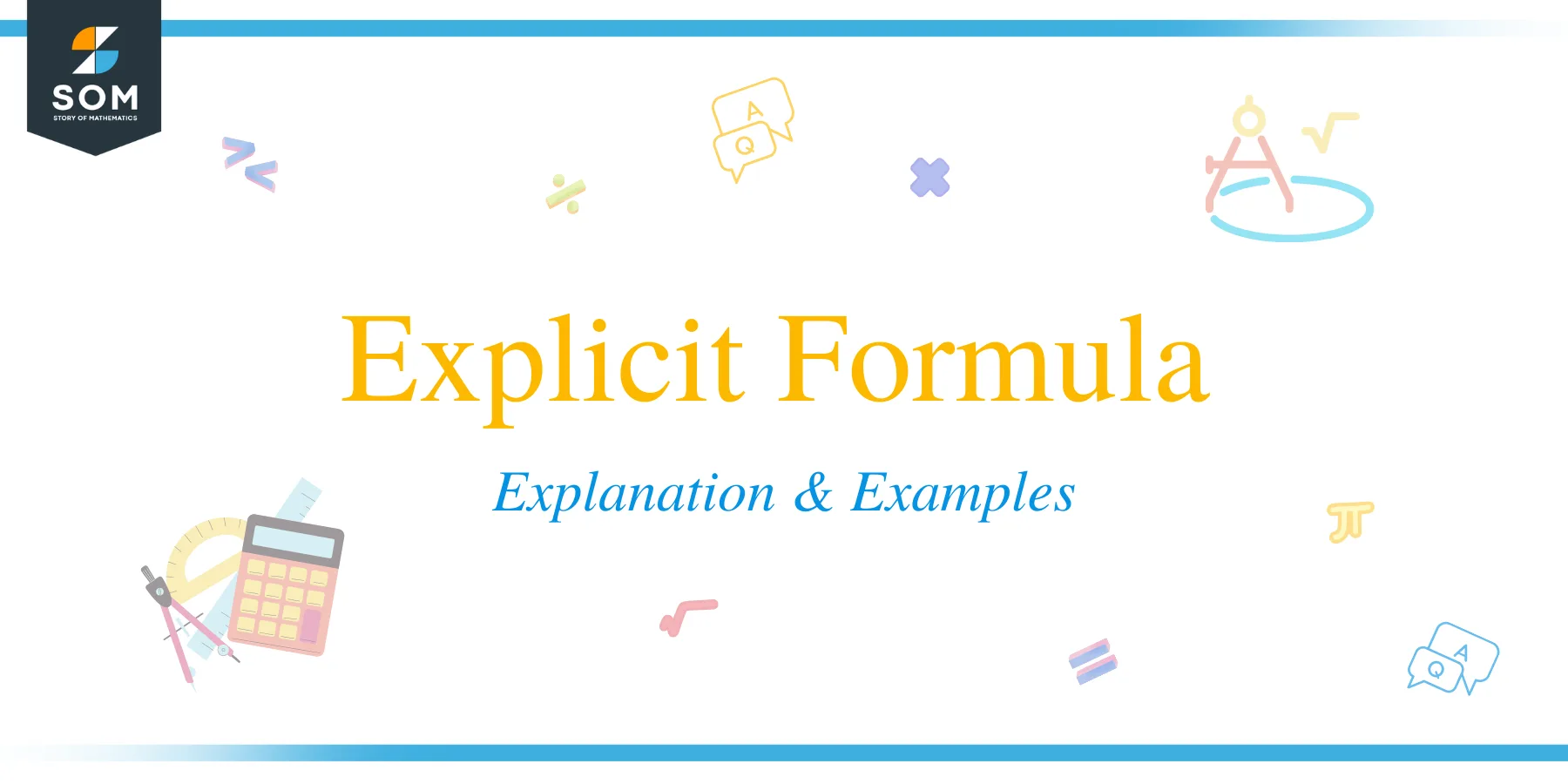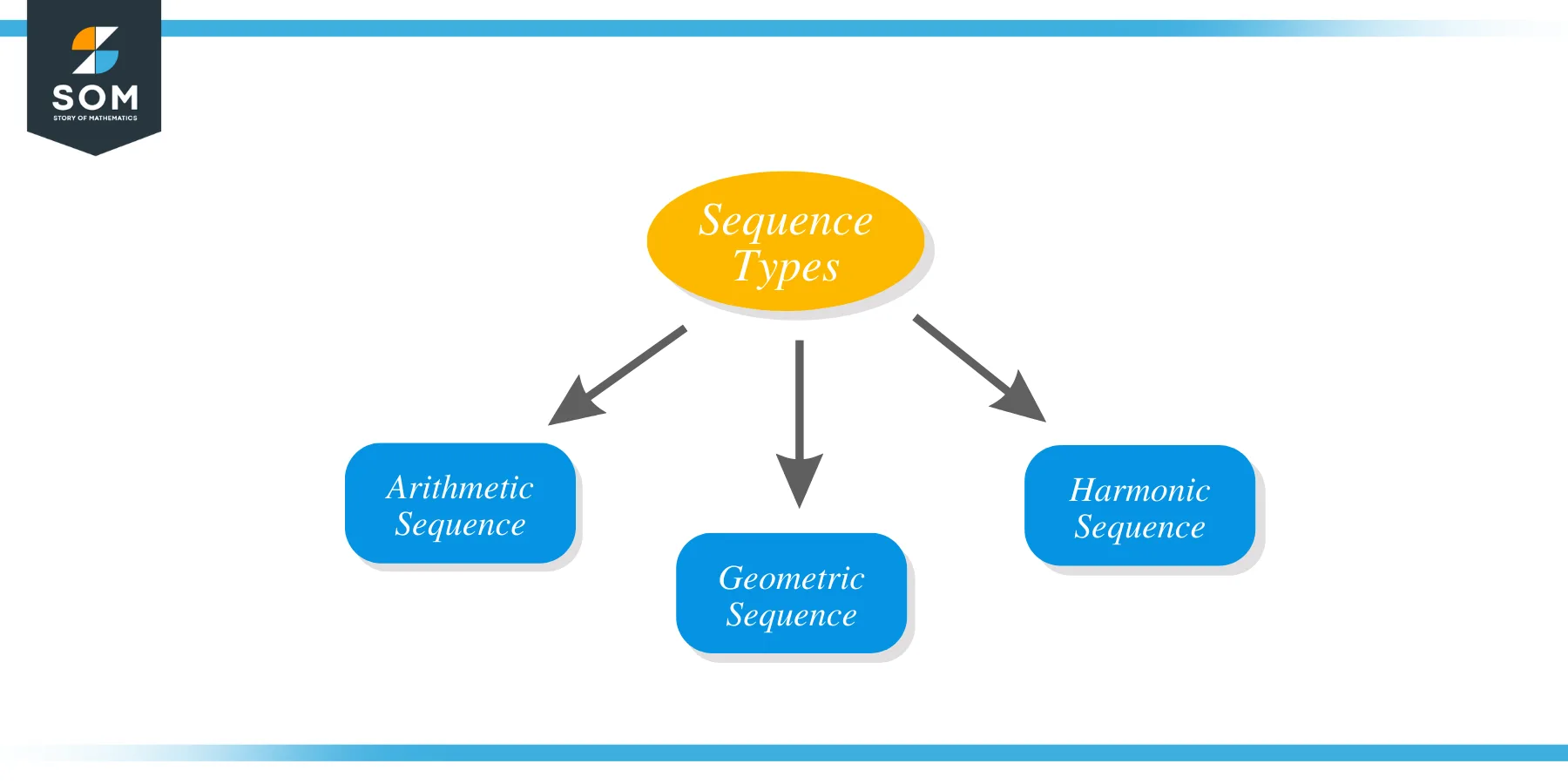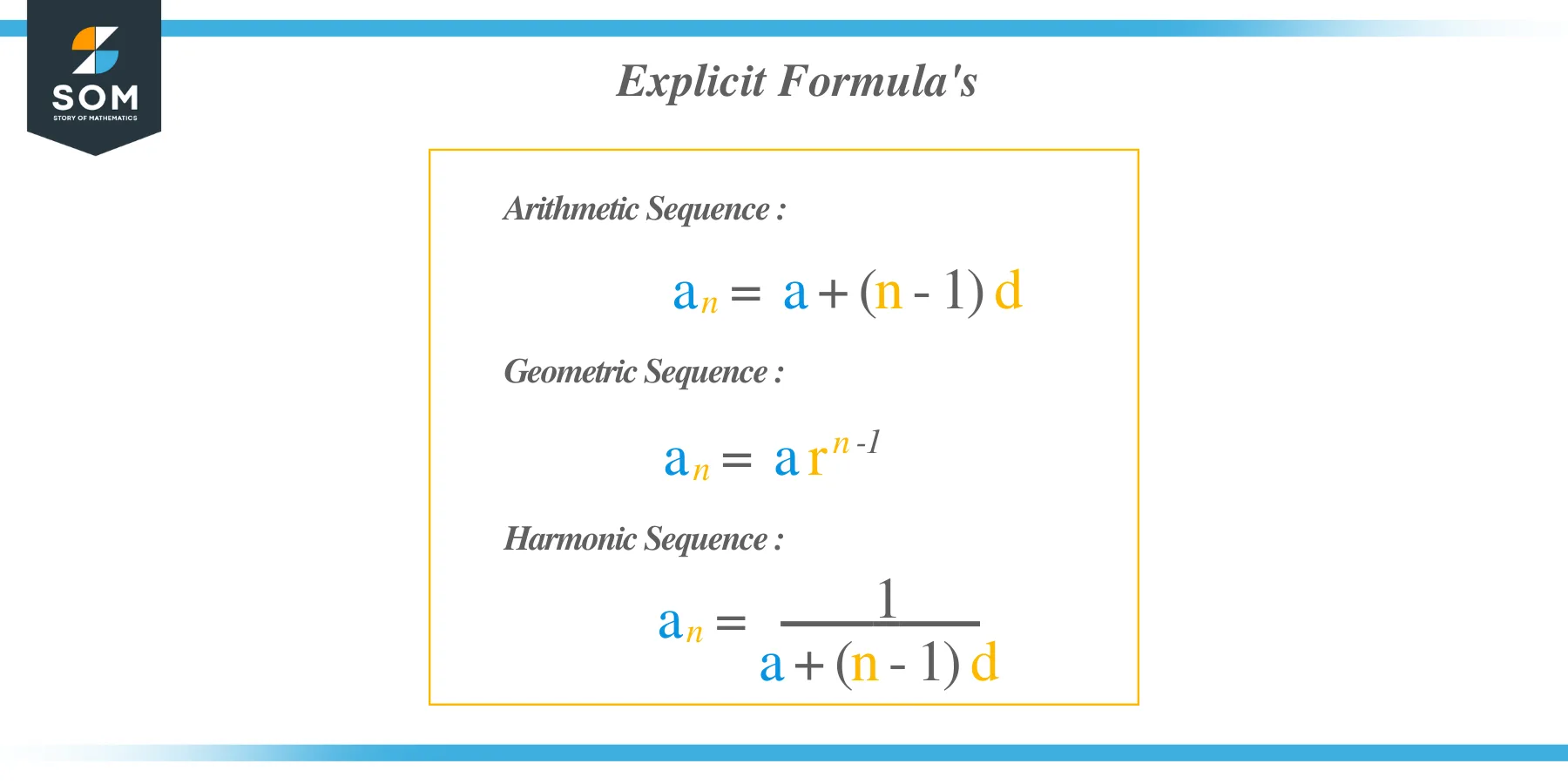JUMP TO TOPIC
 An explicit formula is used to calculate the nth term of a sequence by explicitly or directly putting in the value of n.
An explicit formula is used to calculate the nth term of a sequence by explicitly or directly putting in the value of n.
For example, if you want to determine the $6^{th}$ term of the sequence, then you will put $n = 6$. The explicit formula is generally written as $a_{n} = a + (n-1) d$, but this formula is used to determine the terms of an arithmetic sequence. We can use the explicit formula to find the terms of arithmetic, geometric and harmonic sequence.
In this article, we will discuss in detail different sequences and their explicit formulae, along with numerical examples.
What Is an Explicit Formula?
An explicit formula is a formula that is used to determine the $n^{th}$ term of different types of sequences.
There are different types of explicit formulae, mainly divided into three types, i.e., arithmetic, geometric and harmonic sequences. Explicit means direct or exact; hence, when applied correctly, we can calculate any term of the given sequence immediately.
What Is a Sequence?
A sequence is a series of numbers which share a common pattern. The sequence can be finite or infinite. The infinite sequence has three dots at the end. For example, $1$,$2$,$3$,$4$… will be called an infinite sequence, while $1$,$2$,$3$ will be called a finite sequence.
The numbers in the sequence are called terms. For example, in the sequence, $1$,$2$,$3$, the number “$1$” is called the 1st term of the sequence and similarly, the number $3$ is called the $3rd$ term of the sequence. There are different types of sequences, but for this topic, we will discuss arithmetic, geometric and harmonic sequences.

Arithmetic Sequence
An arithmetic sequence is a sequence in which the common difference between the terms of the sequence remains constant. We can also define an arithmetic sequence as a sequence in which the same number is added or subtracted to each term of the sequence to generate a constant pattern.
In the sequence $0$,$2$,$4$,$6$, $8$, we are adding “2” to each term of the sequence, or we can say that the common difference is “$2$” between each term of the sequence.
Geometric Sequence
A geometric sequence is a type of sequence in which each term is multiplied by a constant number, or we can also define it as a sequence in which the ratio of the consecutive terms or numbers in the sequence remains constant.
For example, suppose we were given a sequence of $2$,$4$,$8$,$16$,$32$ and so on. In this sequence, we multiply each term by the number “$2$”. Note that the ratio between consecutive terms remains the same. The ratio between $4$ and $2$ is $\dfrac{4}{2} = 2$; similarly, the ratio between $8$ and $4$ is $\dfrac{8}{4} = 2$.
Harmonic Sequence
A harmonic sequence is a type of sequence which is inverse of the arithmetic sequence. For example, if we are given an arithmetic sequence of $x_{1}$,$x_{2}$,$x_{3}$… then the harmonic sequence will be $\dfrac{1}{x_1}$, $\dfrac{1}{x_2}$,$\dfrac{1}{x_3}$. The harmonic sequence or harmonic progression is simply the reciprocal of an arithmetic sequence.
Explicit Formula for an Arithmetic Sequence
We can use the explicit formula for an arithmetic sequence to determine any term of the sequence, even if limited data is provided for the sequence. As the name explicit means direct, we can directly find out a specific term without calculating the terms before and after it.
Suppose we want to determine the 8th term of the sequence, then it is not necessary to find out the $7^{th}$ or $9^{th}$ terms before calculating the $8^{th}$ term of the sequence.
The explicit formula for an arithmetic sequence is given as
$a_n = a + (n-1) d$
Here:
a = First Term of the sequence
d = common difference
n = number of the term
Let us study an example related to the arithmetic sequence. For example, we are given a sequence $1$, $5$, $9$, $13$, $17 \cdots$. The first term of the sequence is $1$, hence $a = 1$. We can calculate the common difference by subtracting two consecutive terms $d = 5 – 1 = 4$ or $d = 9 – 5 = 4$. Now that we have the value of the first term and the common difference of the sequence, we can find the value of any term of the sequence. Say we want to find the value of the $10^{th}$ term of the sequence, so $n = 10$.
$a_{10} = 1 + (10 – 1) 4$
$a_{10} = 1 + (9) 4$
$a_{10} = 1 + 36 = 37$
So the $10^{th}$ term of the sequence is $37$.
Let us study some explicit formula examples.
Example 1: Determine the first three terms for the given arithmetic sequences.
- $a = 3$ and randomly chosen three consecutive terms are $39$,$42$ and $45$
- $a = 1$ and randomly chosen three consecutive terms are $36$,$43$ and $50$
- $a = 9$ and randomly chosen three consecutive terms are $54$,$59$ and $64$
Solution:
1).
We have to calculate the first three terms of the arithmetic sequence.
First, second, and third term can be calculated as $n = 1$ , $n = 2$ and $n = 3$ respectively.
The common difference for this sequence is $d = 42 – 39 = 3$.
$a_{1} = 3 + (1 – 1) 3 = 3$, $a_1 = a = 3$
$a_{2} = 3 + (2 – 1) 3 = 3 + 3 = 6$
$a_{3} = 3 + (3 – 1) 3 = 3 + 6 = 9$
2).
The common difference for this sequence is $d = 43 – 36 = 7$.
$a_{1} = 1 + (1 – 1) 7 = 1, a_1 = a = 1$
$a_{2} = 1 + (2 – 1) 7 = 1 + 7 = 8$
$a_{3} = 1 + (3 – 1) 7 = 3 + 14 = 15$
3).
The common difference for this sequence is $d = 59 – 54 = 5$.
$a_{1} = 9 + (1 – 1) 5 = 9$, $a_1 = a = 9$
$a_{2} = 9 + (2 – 1) 5 = 9 + 5 = 14$
$a_{3} = 9 + (3 – 1) 5 = 9 + 10 = 19$
Example 2: Calculate $n$ for an arithmetic sequence having $a = 10$, $a_{n} = 90$ and $d =10$.
Solution:
We know the explicit formula for an arithmetic sequence is given as:
$a_{n} = a + (n-1) d$
$90 = 10 + (n -1) 10$
$80 = (n-1) 10$
$8 = n – 1$
$n = 9$
Explicit Formula for Geometric Sequence
We can use the explicit formula for the geometric sequence to find out any term of the geometric sequence. For the explicit formula of the arithmetic sequence, we require the first term and the common difference to find out the $n^{th}$ term of the sequence. In this case, we need the first term and the common ratio.
The common ratio of the geometric sequence can be calculated by taking the ratio of the two consecutive numbers in the sequence. A generic geometric sequence is given as $a$, $ar$, $ar^{2}$, $ar^{3}$, $ar^{4}$… $ar^{n-1}$. The explicit formula for the geometric sequence is given as:
$a_{n} = ar^{n-1}$
Here:
a = First term of the sequence
r = common ration = $\dfrac{ar}{a}$ or $\dfrac{ar^{2}}{ar}$
Say we are given a geometric sequence $1$,$6$,$36$, $216$… and we need to find out the $7^{th}$ term of the geometric sequence. Here, $a = 1$ while $r = \dfrac{6}{1}= 6$ or $r = \dfrac{36}{6} = 6$. We want to find the 7th term using the explicit geometric sequence formula.
$a_{7} = 1 \times (6)^{7 – 1} = 1 \times 6^{6} = 46,656$
Example 3: Determine the fifth and sixth terms for the given geometric sequences.
1. $4$,$8$,$12$,…
2. $7$, $14$, $21$, $28$…
Solution:
1).
We are given the first three terms of the sequence. So $a_{1} = 4$, $a_{2} = 8$ and $a_{3} = 12$
Common Ratio $= r =\dfrac{a_2}{a_1}= \dfrac{8}{4} = 2$
We need to find the fifth and sixth terms of the sequence, and we know the explicit formula for the geometric sequence is:
$a_{n} = ar^{n-1}$
$a_{5} = 4.(2)^{5-1}$
$a_{5} = 4.(2)^{4} = 4 \times 16 = 64$
$a_{6} = 4.(2)^{6-1}$
$a_{6} = 4.(2)^{5} = 4 \times 32 = 128$
2).
We are given the first four terms of the sequence. So $a_{1} = 7$, $a_{2} = 14$, $a_{3}= 21$ and $a_{4} = 28$.
Common Ratio $= r =\dfrac{a_2}{a_1}= \dfrac{14}{7} = 2$.
$a_{n} = ar^{n-1}$
$a_{5} = 7.(2)^{5-1}$
$a_{5} = 7.(2)^{4} = 7 \times 16 = 112$
$a_{6} = 7.(2)^{6-1}$
$a_{6} = 7.(2)^{5} = 7 \times 32 = 224$
Explicit Formula for Harmonic Sequence
We can use the explicit formula for a harmonic sequence to determine any term in a given harmonic sequence. We know that a harmonic sequence is an inverse or reciprocal of an arithmetic sequence. The general representation of a harmonic sequence can be given as $\dfrac{1}{a}$, $\dfrac{1}{a + d}$, $\dfrac{1}{a+2d}$,…, $\dfrac{1}{a + (n-1) d}$. The explicit formula for the harmonic sequence is written as:
$a_{n} = \dfrac{1}{a + (n-1) d}$
a = First Term of the sequence
d = common difference
n = number of the term
We can easily determine the value of any term of a geometric sequence using the above-mentioned explicit formula. Say we are given a harmonic sequence $\dfrac{1}{3}$, $\dfrac{1}{6}$, $\dfrac{1}{9}$,$\dfrac{1}{12}$… Let us first consider if the arithmetic sequence is corresponding to this harmonic sequence. The first term of that arithmetic sequence is $a = 3$ while the common difference $d = 6 – 3 = 3$ or $d = 12 – 9 = 3$. Suppose we need to find the 9th term of the harmonic sequence. Applying the explicit formula:
$a_{9} = \dfrac{1}{3 + (9-1) 3}$
$a_{9} = \dfrac{1}{3 + (8) 3} = \dfrac{1}{3 + 24} = \dfrac{1}{27}$
Example 4: If the $5^{th}$ and $8^{th}$ terms of a harmonic sequence are $\dfrac{3}{7}$ and $\dfrac{3}{13}$, respectively, find out the harmonic sequence by using these terms.
Solution:
We can say that the $5^{th}$ and $8^{th}$ terms for the arithmetic sequence, in this case, would be $\dfrac{8}{3}$ and $\dfrac{14}{3}$, respectively. So:
$a_{5} = a + 4d = \dfrac{7}{3}$ (1)
$a_{8} = a + 7d = \dfrac{13}{3}$ (2)
Subtracting equation (1) from (2), we will get:
$3d = \dfrac{13}{3} – \dfrac{7}{3} = \dfrac{6}{3} = 2$
$d = \dfrac{2}{3}$
Putting the value of the common difference “d” in equation (1):
$a + 4 (\dfrac{2}{3}) = \dfrac{7}{3} = \dfrac{7}{3} – \dfrac{8}{3} = -\dfrac{1}{3}$
So, $a = a_{1} = -\dfrac{1}{3}$
Remember this $a_{1}$ is for the arithmetic sequence.
Let us now calculate the second, third and fourth term.
$a_{2} = a_{1} + d = -\dfrac{1}{3} + \dfrac{2}{3} = \dfrac{1}{3}$
$a_{3} = a_{1} + 2d = -\dfrac{1}{3} + 2 (\dfrac{2}{3}) = 1$
$a_{4} = a_1 + 3d = -\dfrac{1}{3} + 3 (\dfrac{2}{3}) = \dfrac{5}{3}$
Now, if we take the reciprocal of the above terms, then we will get the harmonic sequence or progression:
$\dfrac{3}{(-1)}$, $\dfrac{3}{(1)}$, $1$, $\dfrac{3}{5}$, $\dfrac{3}{7}$,…
Steps to Apply the Explicit Formulas
If we are dealing with an arithmetic sequence, then we know the formula for the $n^{th}$ term is $a_{n} = a + (n-1)$ d, so all we need to do is to find the value of “$a$” and “$d$”, and we will have the final equation for the $n^{th}$ term of the arithmetic equation. The $n^{th}$ term for an arithmetic sequence can be evaluated using the explicit formula using the steps given below.
- The first step is to find the common difference and the first term of the sequence.
- Put the values of the first term and common difference in the $n^{th}$ term formula.
- Solve the equation to get the $n^{th}$ term formula for the arithmetic sequence.
The explicit formulae for geometric and harmonic sequences can also be applied using the same method. For geometric sequence, you need to find out common ratio instead of common difference, while for harmonic sequence, just follow the procedure of arithmetic sequence and take the inverse at the end.
Example 5: If $a_{n-3} = 4n – 11$, then what will be the $n^{th}$ term of the sequence?
Solution:
We are given an explicit formula for the sequence, and with the help of it, we need to determine the sequence’s $n^{th}$ term. First, we need to find out $a_{1}$ and $d$. Let us find out the first three terms of the sequence at n = $4$,$5$,$6$.
$a_{4-3} = 4(4) – 11 = a_1 = 16 -11 = 5$
$a_{5-3} = 5(4) – 11 = a_2 = 20 -11 = 9$
$a_{6-3} = 6(4) – 11 = a_3 = 24 -11 = 13$
So the first three terms of the sequence are $5$,$9$,$13$.
The common difference of the sequence $d = 9 – 5 = 4$.
$a_{n} = 5 + (n-1) 4$
$a_{n} = 5 + 4n- 4$
$a_{n} = 4n + 1$
Example 6: Determine the $n^{th}$ term of the geometric sequence if $\dfrac{a_7}{a_5} = \dfrac{16}{9}$ and $a_{2} = \dfrac{4}{9}$.
Solution:
We can write $a_{7} = a_1.r^{6}$ and $a_{5} = a_1.r^{4}$.
$\dfrac{a_7}{a_5} = \dfrac{16}{9}$
$\dfrac{ a_1.r^{6}}{ a_1.r^{4}} = \dfrac{16}{9}$
$r^{2} = \dfrac{16}{9} = \pm \dfrac{4}{3}$
We know that $a_{2} = a_{1}.r$
$a_{2} = \dfrac{4}{9}$
$a_{1}.r = \dfrac{4}{9} = a_{1} = \dfrac{4}{9r}$
So, when $r = \dfrac{4}{3}$ then $a_{1}$ will be
$a_{1} = \dfrac{4}{9.\dfrac{4}{3}} = \dfrac{4}{12} = \dfrac{1}{3}$
So when $r = -\dfrac{4}{3}$, then $a_{1}$ will be:
$a_{1} = \dfrac{4}{9.(-\frac{4}{3})} = -\dfrac{4}{12} = -\dfrac{1}{3}$
So when $r = \dfrac{4}{3}$ and $a_{1} = \dfrac{1}{3}$, then the $n^{th}$ term of the sequence will be:
$a_{n} = ar^{n-1}$
$a_{n} = \dfrac{1}{3}.(\dfrac{4}{3}) ^{n-1}$
When $r = -\dfrac{4}{3}$ and $a_{1} = -\dfrac{1}{3}$, then the $n^{th}$ term of the sequence will be:
$a_{n} = ar^{n-1}$
$a_{n} = -\dfrac{1}{3}.(-\dfrac{4}{3}) ^{n-1}$
Example 7: Determine the $7^{th}$ and $n^{th}$ term of the harmonic sequence $\dfrac{1}{3}$,$\dfrac{1}{5}$,$\dfrac{1}{7}$,…
Solution:
If we take the reciprocal of the sequence, it will give us the arithmetic sequence. We can write the arithmetic sequence as $3$,$5$,$7$…
Here $a = 5$ and $d = 5-3 = 2$
$a_{n} = a + (n-1) d$
$a_{n} = 5 + (n -1) 2$
$a_{n} = 5+ 2n -2 = 2n + 3$
So the $n^{th}$ term of the harmonic sequence will be:
$\dfrac{1}{ a_{n} } = \dfrac{1}{2n + 3}$
We can easily calculate the 7^{th} term of the sequence now by putting $n = 7$.
$\dfrac{1}{ a_{7}} = \dfrac{1}{2(7) + 3} = \dfrac{1}{17}$
Example 8: Suppose a theatre has $10$ rows, and the seats from row $1$ to row $10$ follow a specific pattern. The total number of seats in the first row is $6$ while the number of seats in the second is $8$ and in the third-row, the total number of seats is $10$. By using the explicit formula, determine the number of seats in the $9^{th}$ row.

Solution:
We can write the sequence as $6$,$8$,$10$,…
So here, $a_{1} = 6$ and $d = 8-6 = 2$ and as we want to determine the number of seats in the $9^{th}$ row, hence $n = 9$. The explicit formula is:
$a_{n} = a_1 + (n-1) d$
$a_{9} = 6 + (9-1) 2 = 6 + 16 = 22$
So the number of seats in the $9^{th}$ row will be $22$.
Practice Questions
- Find out the explicit formula for the arithmetic sequences $4$,$7$,$10$,$13$,$16$…
- Find out the 6th term of the geometric sequence $5$,$15$,$45$,…
- If the $6^{th}$ term of the arithmetic progression is $14$ and the $20^{th}$ term is 42, what will be the value of $a_{n}$ and $a_{13}$?
- What is a recursive arithmetic formula?
- Determine if the sequence is arithmetic. If it is, find the common difference and the explicit formula. 6,8,9,11…
Answer Key:
1).
$a = 4$
$d = 7 – 4 = 3$
$a_{n} = 4 + (n-1) 3 = 3n + 1$
2).
$a = 5$
$r = \dfrac{15}{5} = 3$
$a_{n} = a.r^{n-1}$
$a_{6} = 5. (3)^{6-1} = 5 \times 243 = 1215$
3).
$a_{6} = 14$
$a_{20} = 42$
$a_{6} = a + 5d = 14 (1)$
$a_{20} = a + 19d = 42 (2)$
Subtracting eq (1) from (2):
$14 d = 28$
$d = 2$
Putting the value of “d” in eq (1):
$a + 5 (2) = 14$
$a + 10 = 14$
$a = 4$
So now that we have the value of the first term and common difference “$d$”, we can easily find out the $n^{th}$ term of the sequence.
$a_{n} = 4 + (n-1) 2 = 2 (n +1)$
We can calculate the $13^{th}$ term by simply putting $n = 13$ in the above equation.
$a_{13} = 2 (13+1) = 28$
4).
Recursive and explicit formulas are not much different. Basically, Recursive formulas are drawn from explicit formulas. We know that the explicit formula for an arithmetic sequence is:
$a_{n} = a +(n-1)d$
If we want to find out the third term, we will write $a_{3} = a + (3-1) d = a_{1} +2d$ and we know that $a_{2} = a_{1} + d$, so we can write $a_{3} = a_{2} + d$. We can write the recursive formula for an arithmetic sequence as:
$a_{n} = a_{n-1} + d$
5).
The sequence is not an arithmetic sequence because the common difference does not remain the same.
$d = 8 – 6 = 2$
$d = 9 – 8 = 1$
